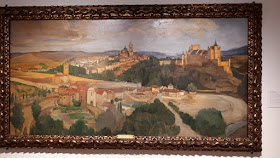Saturday, November 09, 2019
Pictures and such like
My brother and sister-in-law have been staying with us for a few days. On Thursday, we went to an exhibition of the paintings of Mary Cameron (1865-1921), of whom none of us had ever heard. She was an Edinburgh artist and was rather good - good enough not to be forgotten. we felt. Above, she painted a picture of a French soldier being shot - an unusual choice for a lady. I think she's captured the movement very well. Not that I've ever seen someone being shot, I'm thankful to say.
She also worked a lot in Spain, notably painting bullfights - also quite surprising.
This is Segovia. I like the way she's rendered the light.
Then today, Brother and Mrs Brother were at an event, so Mr L and I took ourselves to an exhibition at the museum about Scotland - Wild and Majestic - Romantic Visions of Scotland. It was very interesting - dealing with the emergence of Scotland as a place with a romantic image. Above are two members of the household of the Chief of Clan Grant, painted in 1714. At that point, Highlanders were seen by some southerners and wild and uncivilised, but these portraits were designed to impress visitors with the Laird of Grant's authority as a traditional leader.
After the Battle of Culloden in 1746, in which the Jacobites led by Bonnie Prince Charlie were defeated by the army of King George II, Scots were forbidden to wear Highland dress, including the kilt and tartan. Above is a translation of a Gaelic poem expressing what this veto of their traditional dress meant.
When the ban was lifted in 1782, tartan became very fashionable. This dress was worn by Mary Jane MacDougall when she was presented to George IV on his visit to Edinburgh in 1822. It's decorated, would you believe, with beetles' wings. Imagine having to sew these on!
It seems very hard on the dressmaker, not to say the beetles - but on the other hand their wings are still beautiful, which is more than one can say for Mary Jane, or come to that George IV.
We then walked down into Princes Street, where the gardens were also looking lovely in the sunshine. This is a statue of Wojtek, a bear adopted by a Polish regiment in World War II. He helped carry ammunition, was promoted to colonel and ended his life in Edinburgh Zoo.







This is a fascinating post, from the painting of a French soldier being shot, to the sculpture of the bear and his story. I did not know about the kilt and tartan being banned for a while, how harsh for the people to endure.
ReplyDeleteWe were there last month and saw the bear sculpture. We didn't know the story-thanks for posting!
ReplyDeleteWhat a fascinating post. I remember seeing that bear last time I was in Edinburgh but did not know the story behind it.
ReplyDeleteOh, my, such great memories of my visit! I loved the bear and that's a great shot. I wish I'd taken one from farther away. I found Culloden a fascinating place, and bought a tee-shirt there. (the one with all the Scottish cities on it)
ReplyDeleteWhat a very interesting post. But all your posts are interesting! Beetles wings. I am astonished. And I love that first painting. Amazing. My Ferguson ancestors left not that long after Culloden. Their second son Isaac was born in Scotland kn 1752 and their third son Henry (my ancestor) was born in 1753 in Washington County, Pennsylvania. They were from Ayr though, not Highlanders. Henry fought in the American Revolution. And today is November 11th.
ReplyDeleteI have just spent a lovely hour catching up on all of your posts that I have missed. I always feel that I am transported back to Scotland when I read your blogs. I am now settled closer to my grandchildren (2 boys; 4.5 and 1.5, and a soon-to-arrive girl) so I have all of your ideas to draw from. Hopefully I will start to update my blog more regularly. I do so enjoy yours!
ReplyDeleteYou lead such an interesting life Pam! So many exhibitions and events to see -- I love it. I'm amazed that the beetle wings have survived the centuries - you'd think they would deteriorate.
ReplyDelete